Silky-smooth or delightfully chunky, Anko is the sweet soul of traditional Japanese wagashi and contemporary desserts. Learn how to make anko today with just four pantry ingredients.
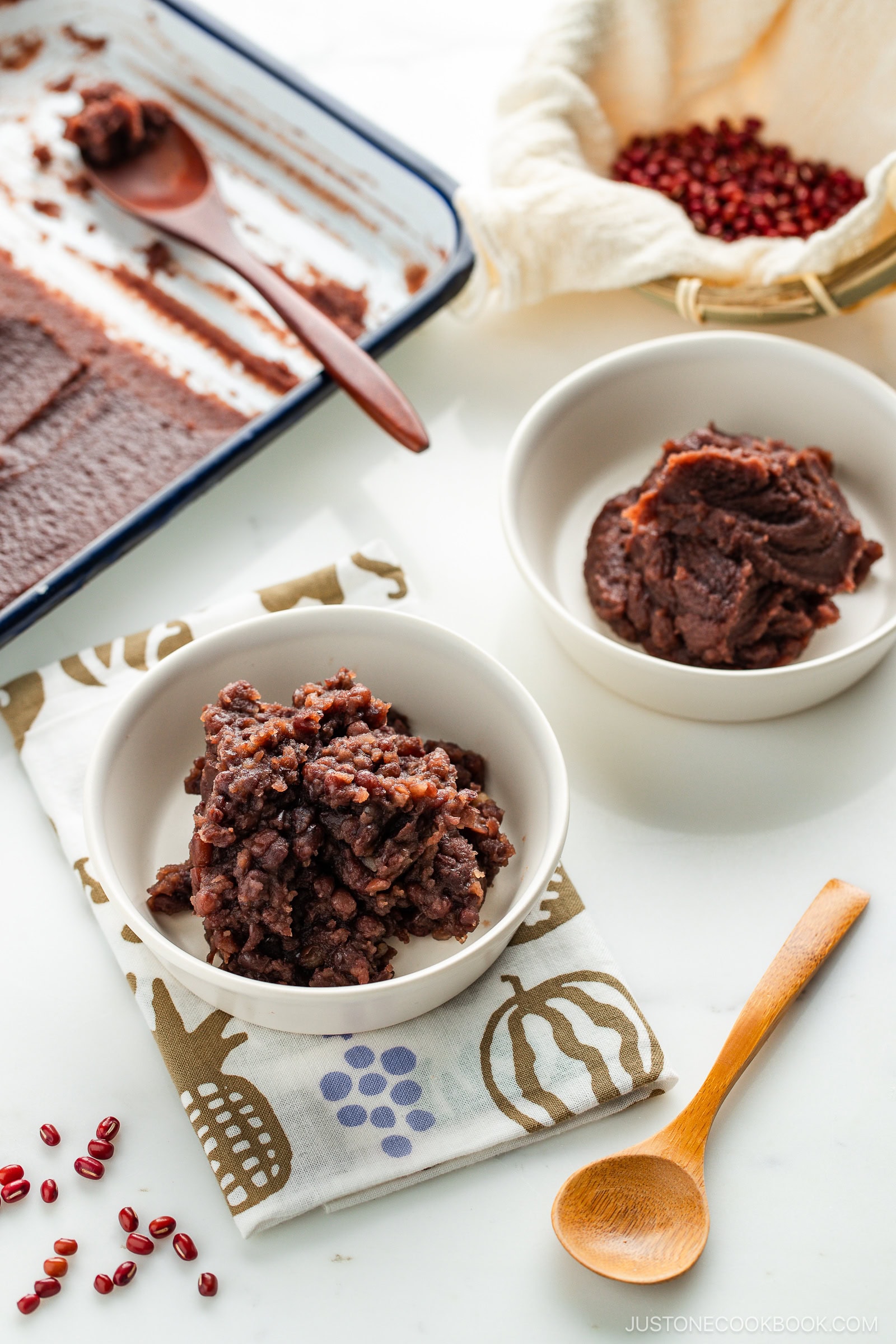
Anko or sweet red bean paste may sound mysterious, but it comes together with nothing more than azuki beans, sugar, salt, and a little patience. I’ll walk you through my easy stovetop method for How to Make Anko and show you how to create both chunky and fine types to fill your favorite Japanese sweets at home.
If you love Japanese sweets with red bean paste, try my Daifuku mochi, Dorayaki, and Taiyaki recipes next!
Table of Contents

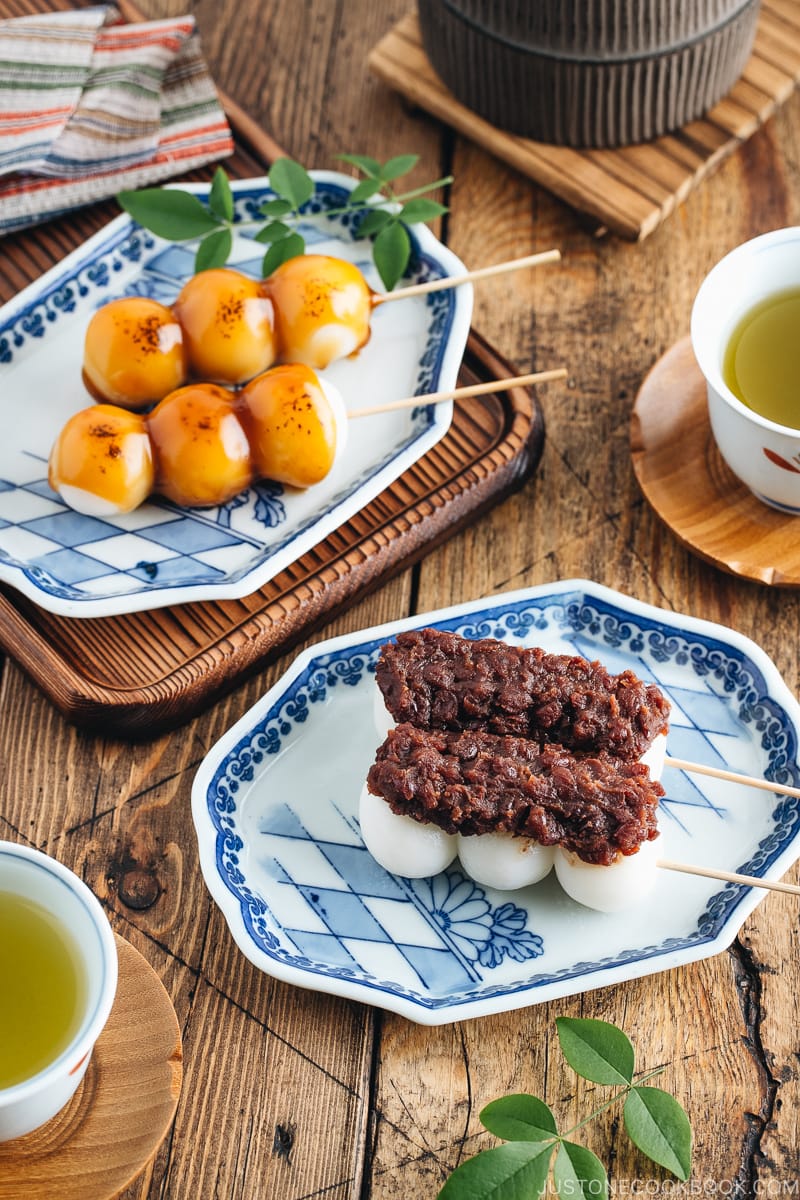
What is Anko?
Anko (餡子) or an (餡) is Japan’s classic sweet red bean paste, simmered from azuki (adzuki) beans and sugar until thick and glossy. There are two beloved textures: rustic and chunky tsubuan (粒あん) and fine and smooth koshian (こしあん). You’ll taste anko in dessert soups, sweet dumplings, sweet mochi rice cakes, even Japanese shaved ice. Once you master the base paste, countless treats open up.
Why I Love This Recipe
- Only 4 ingredients
- No overnight soaking
- Less sugar than store bought
- Easy to purée with a food processor or blender
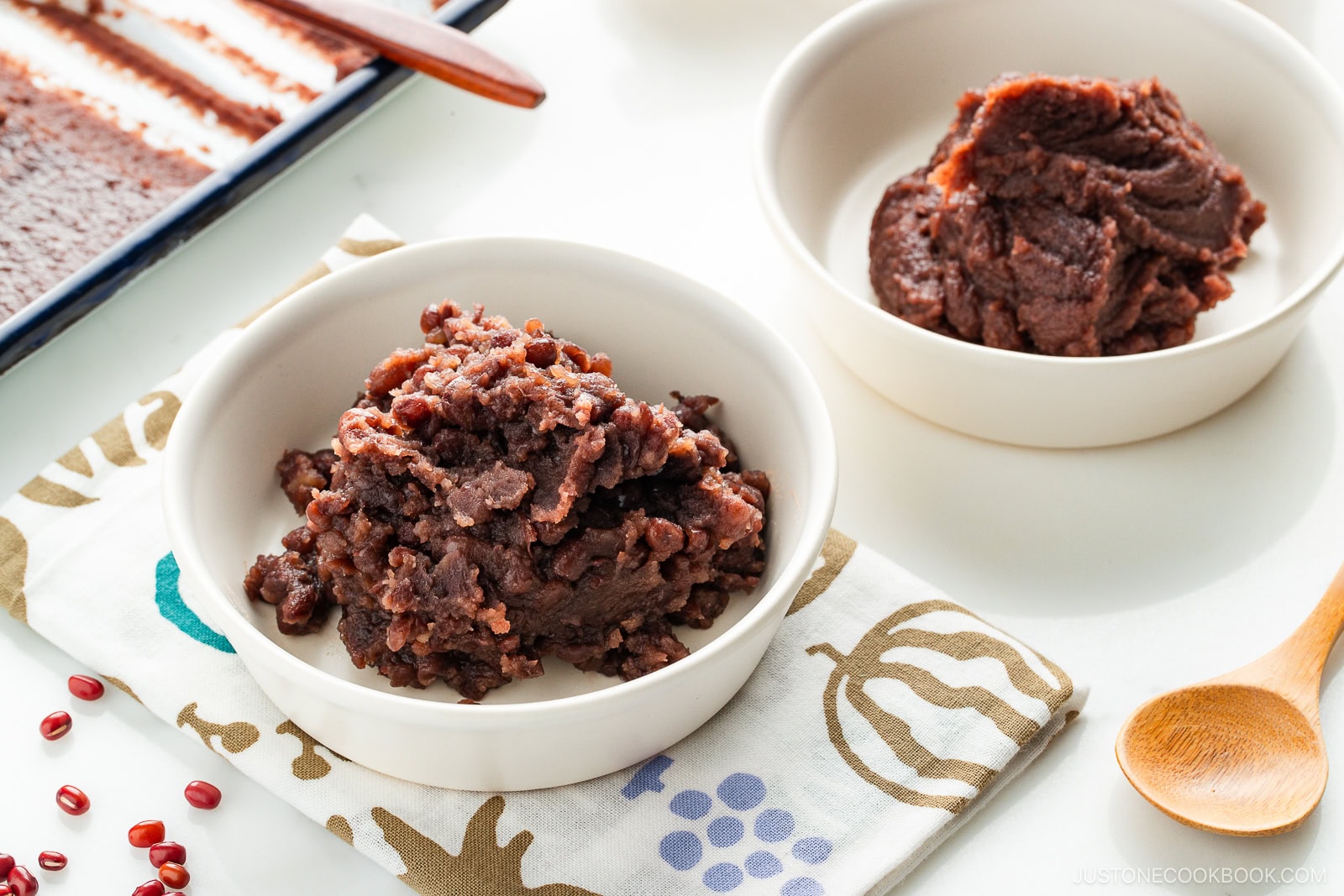
Ingredients for Anko
- Dried azuki beans (also spelled adzuki beans)
- Water
- Sugar (see Tips)
- Kosher salt
Find the printable recipe with measurements below.
Jump to RecipeHow to Make Anko
Preparation
- Rinse and parboil. Pick through the azuki, rinse well, and cover with water in a large pot. Bring to a boil, then drain to remove bitterness.
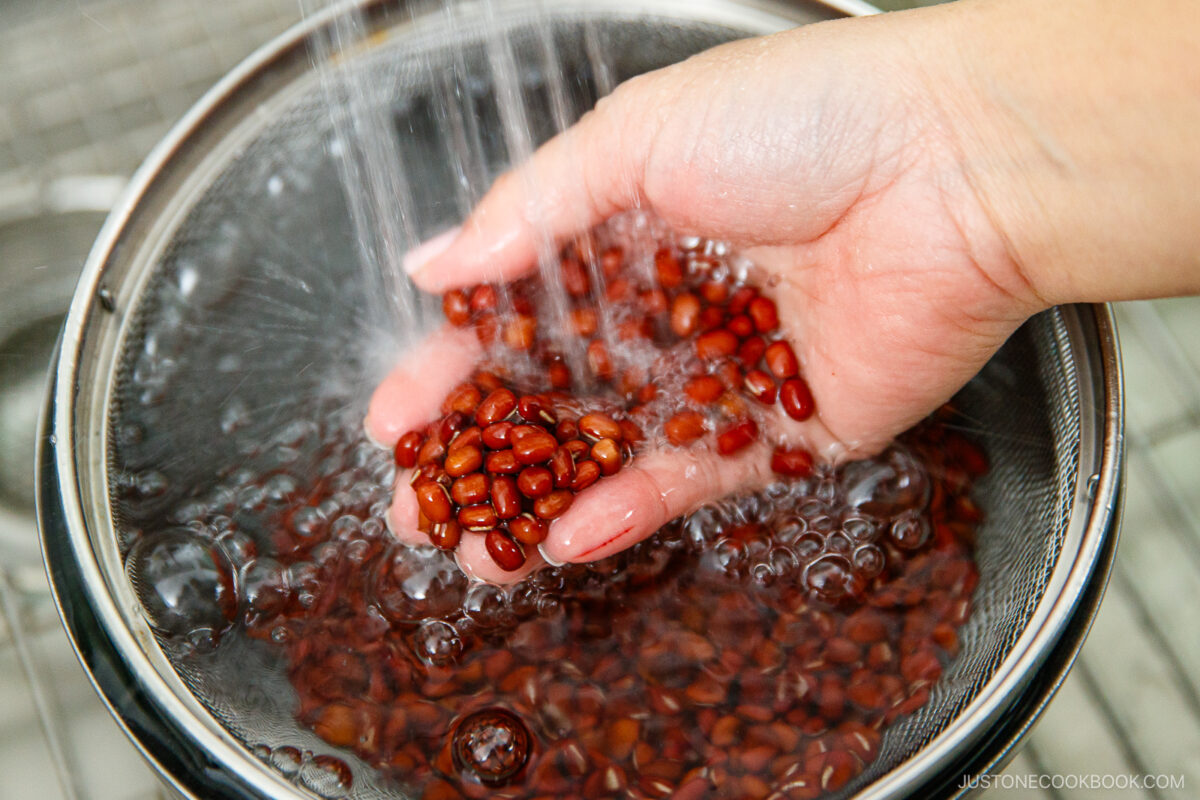
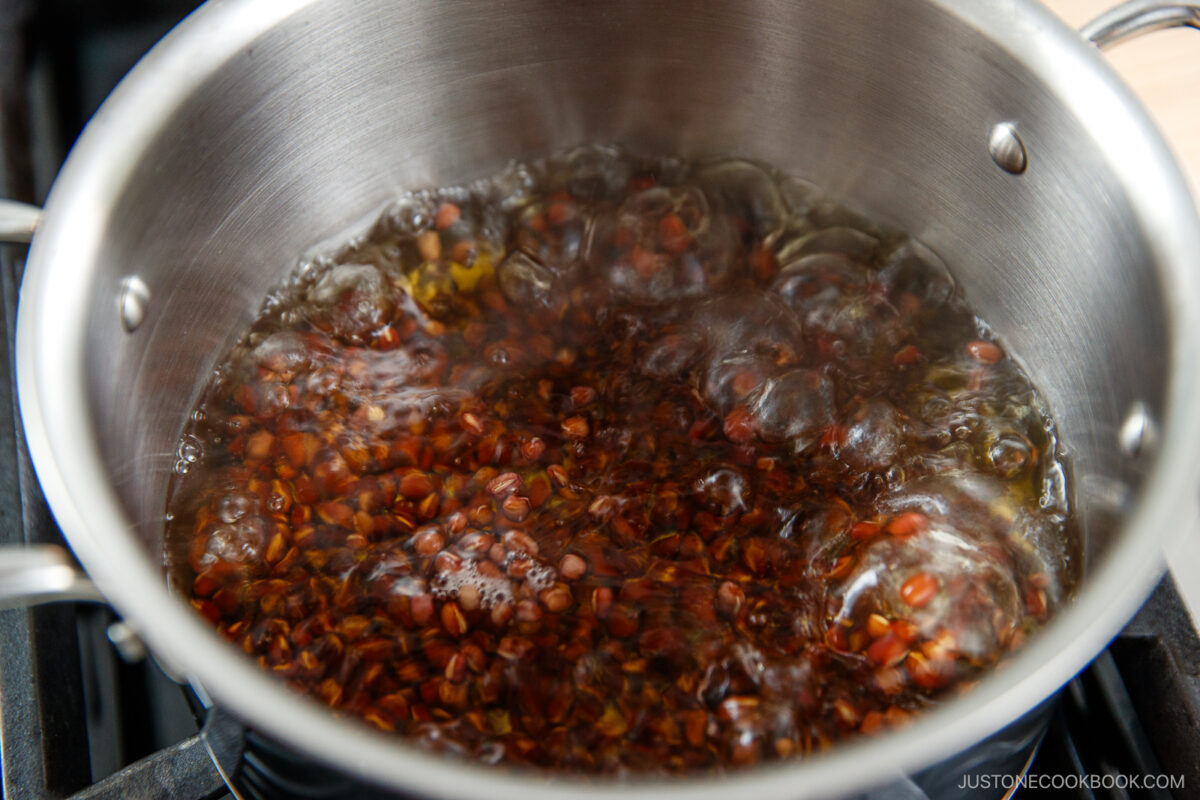
Cooking
- Simmer until tender. Return beans to the pot, add fresh water to cover, and simmer with a drop lid for 60–90 minutes. Top up water as needed. A bean should mash easily between your fingers.
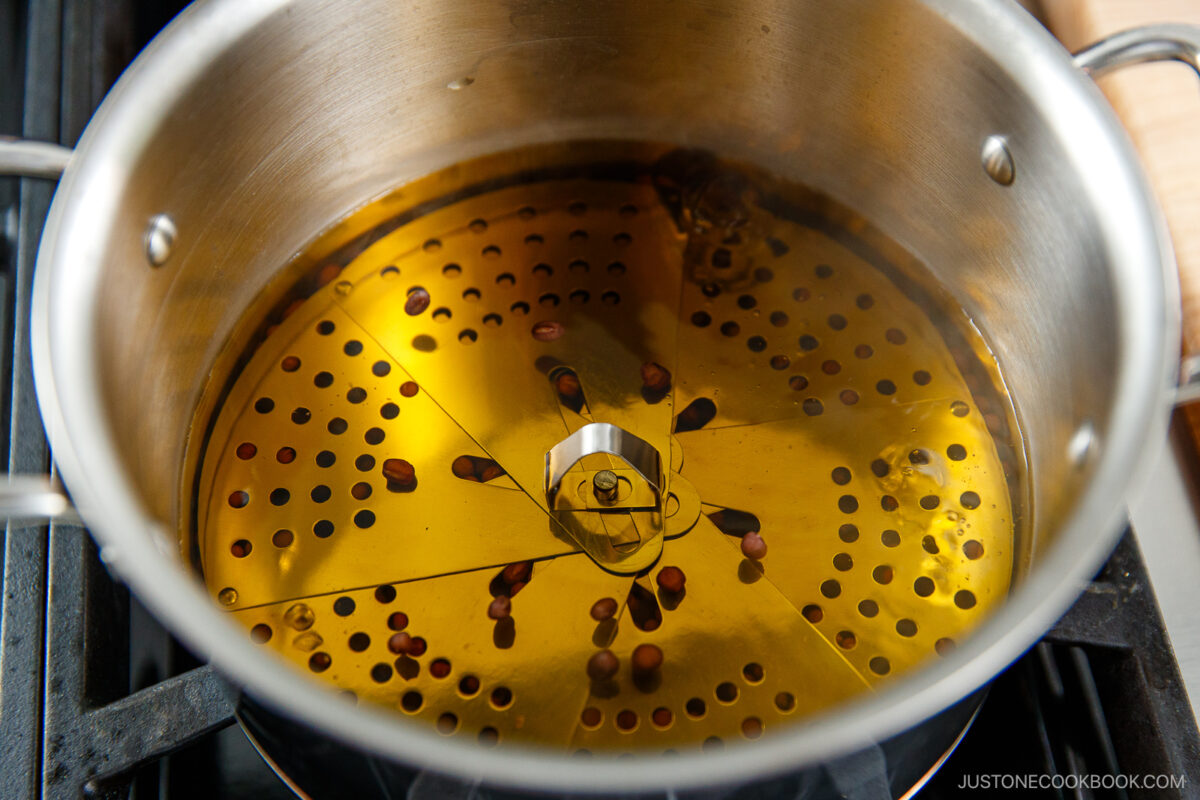
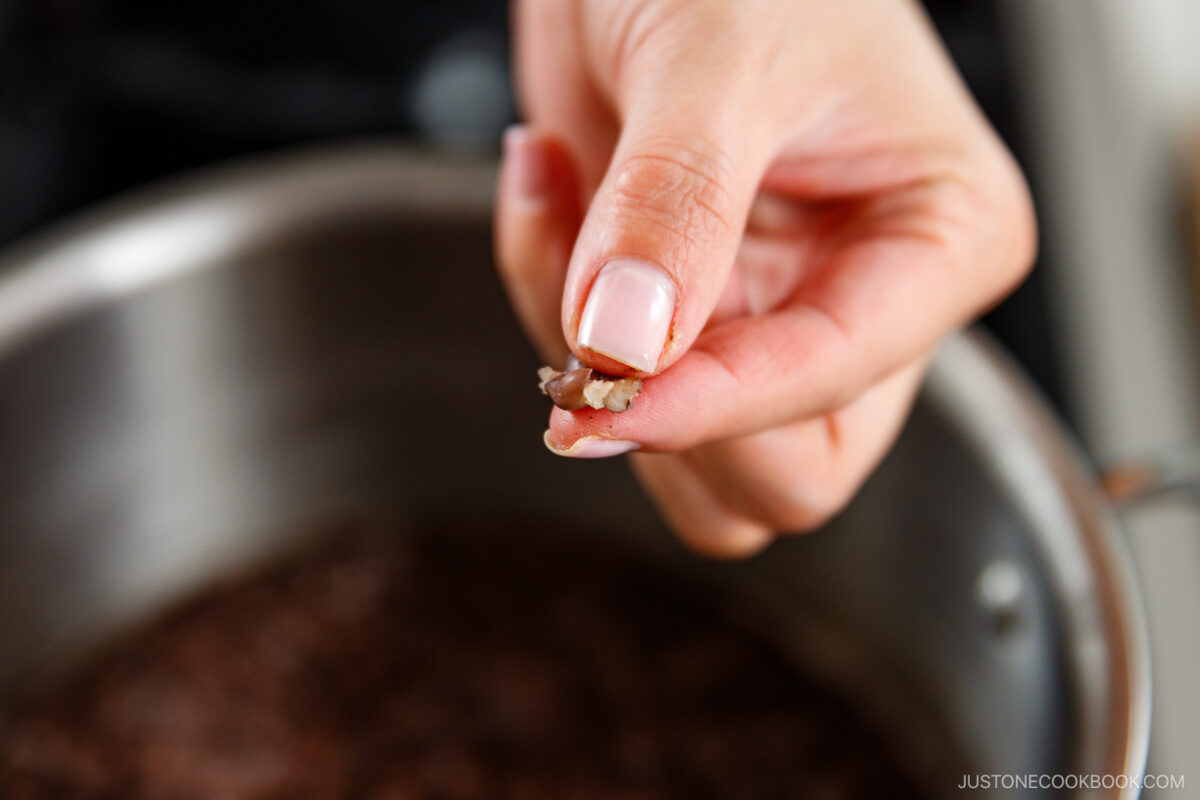
Assemble
- Option 1 – Make tsubuan (chunky paste). Drain beans, return to the pot, and stir in half the sugar over medium-low heat. When dissolved, add the rest of the sugar and the salt. Keep stirring until you can draw a line across the bottom of the pot with a spatula. Spread on a tray to cool (see below).
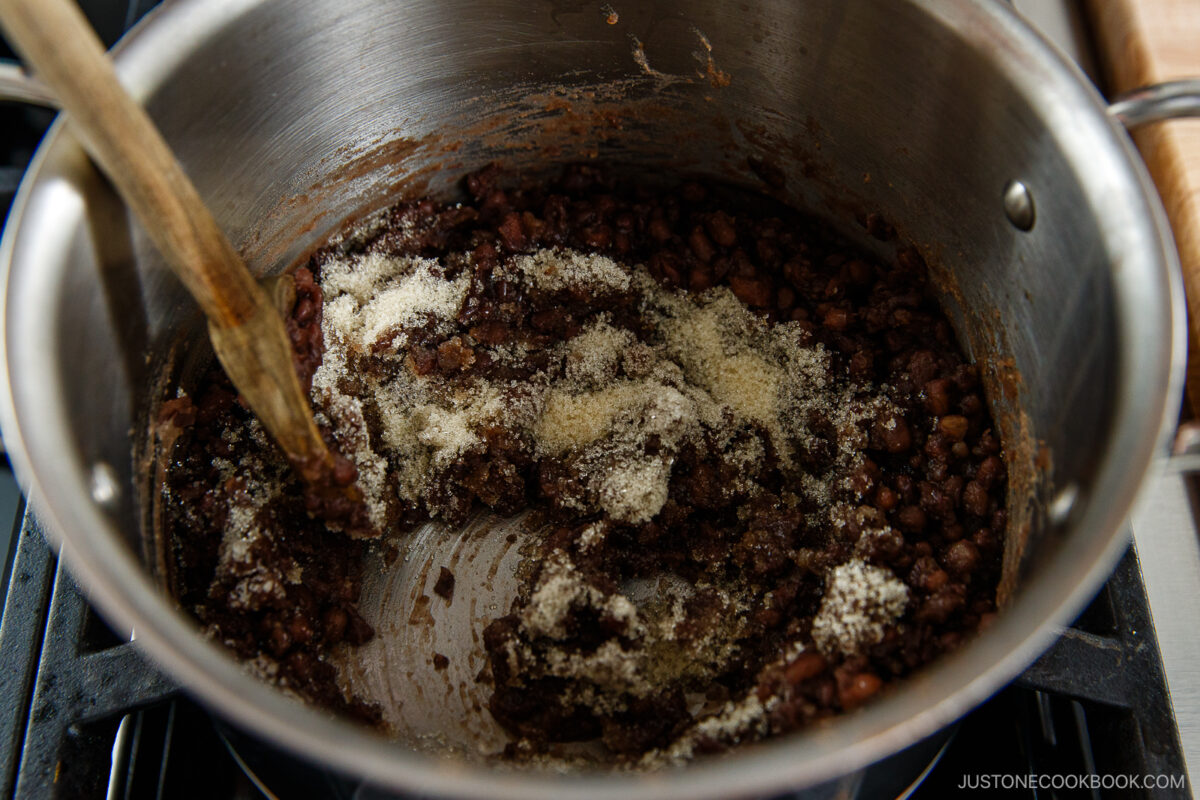
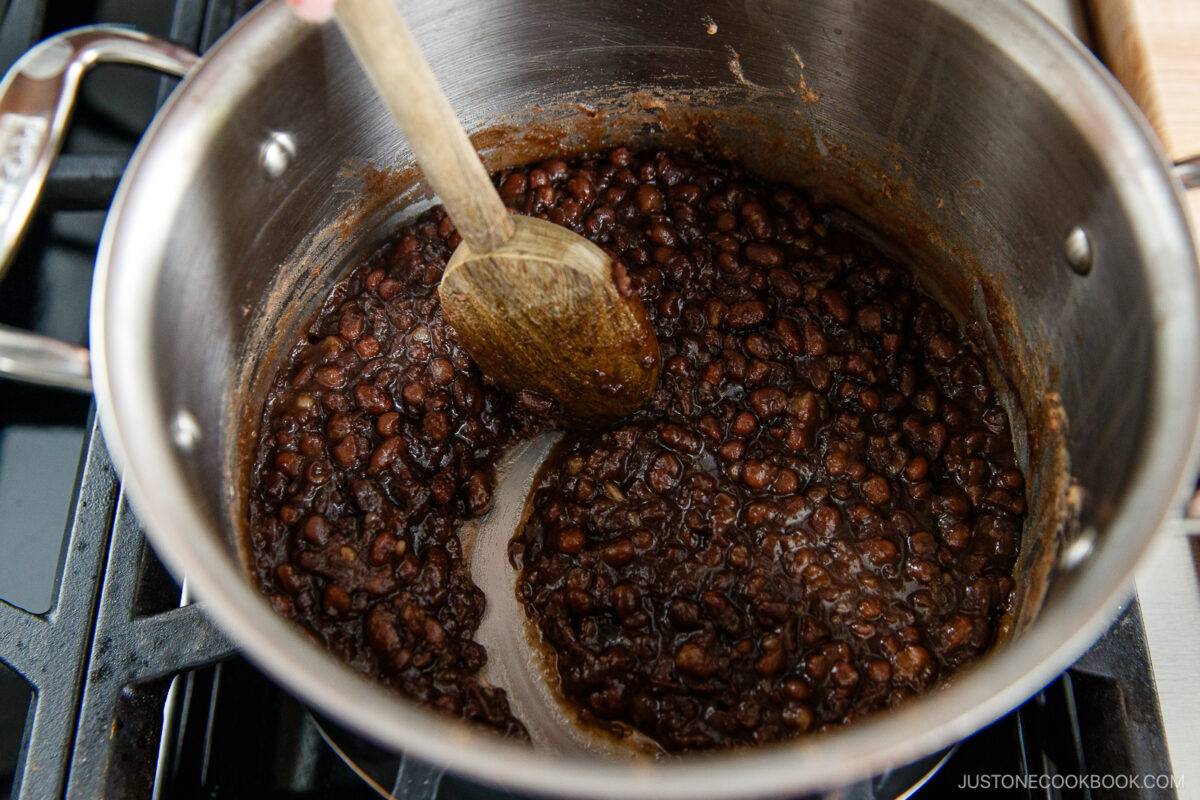
- Option 2 – Make koshian (fine paste). Reserve a little cooking liquid, drain beans, and process to a smooth purée (add liquid only if needed). Return purée to the pot, add sugar in two additions, then salt, and cook down as above. Cool on a tray (see below).
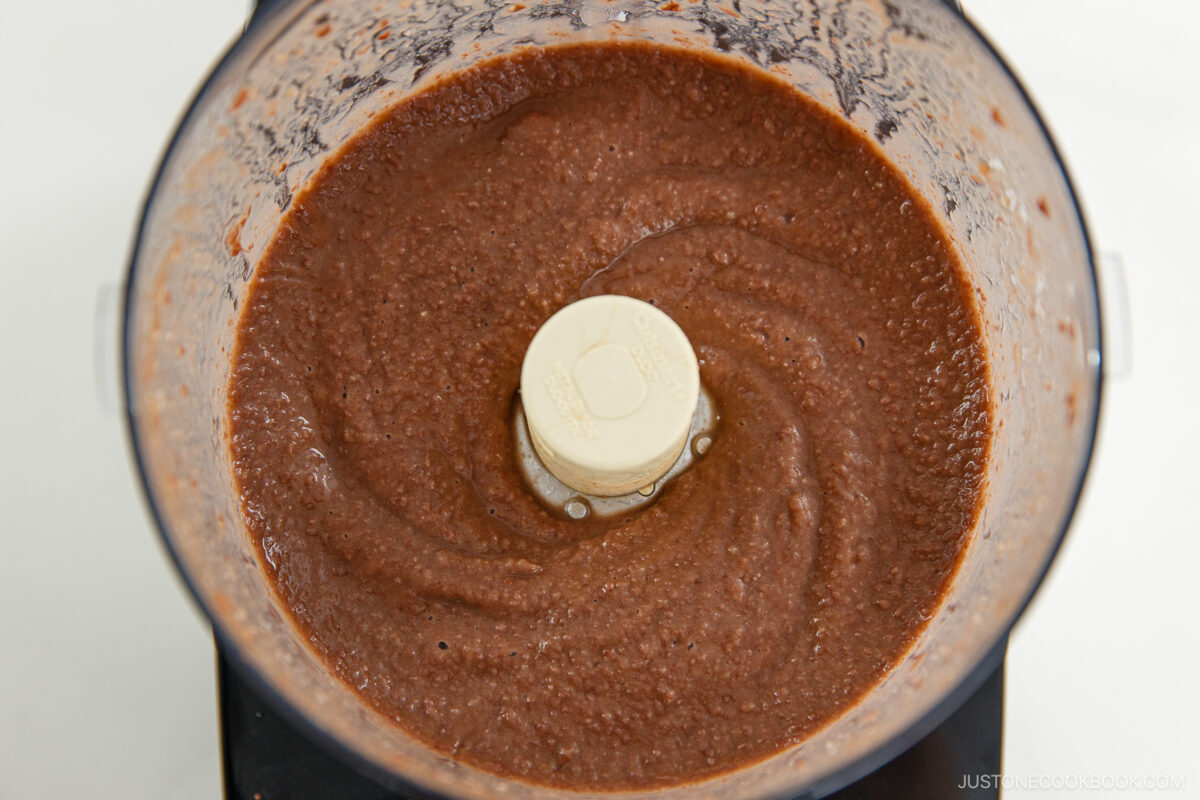
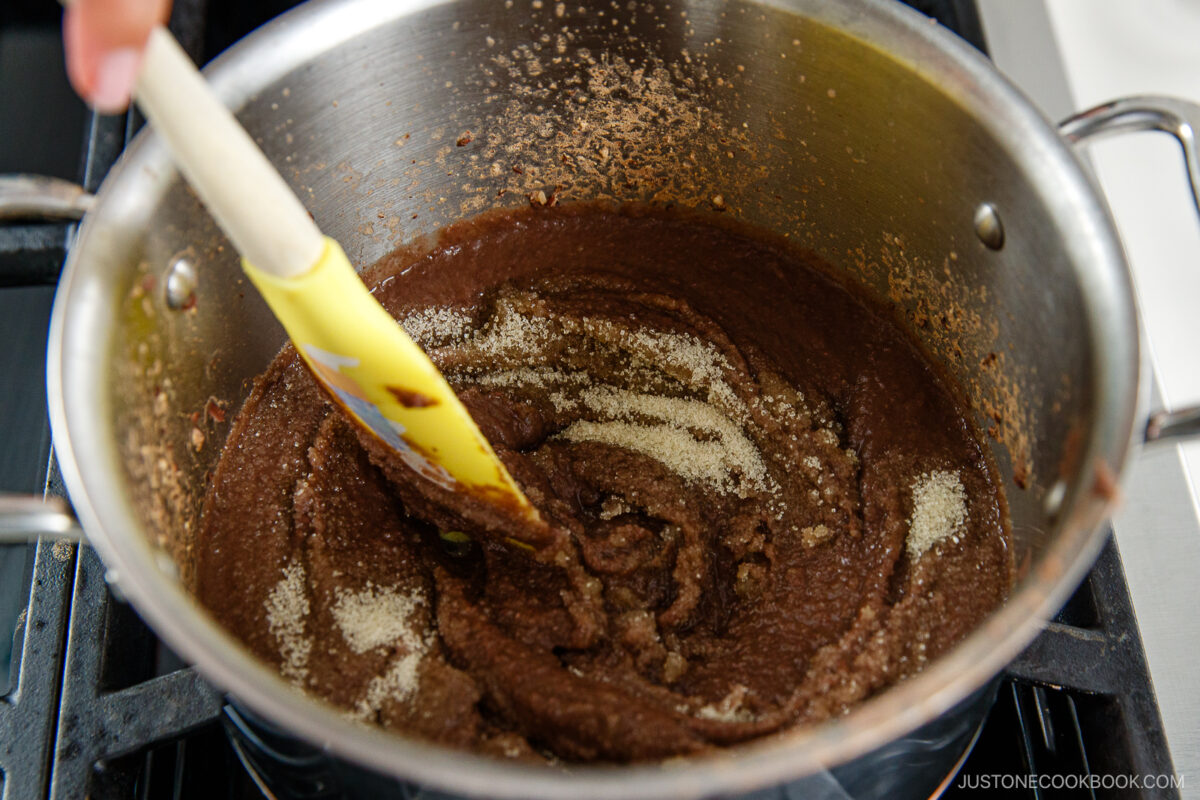
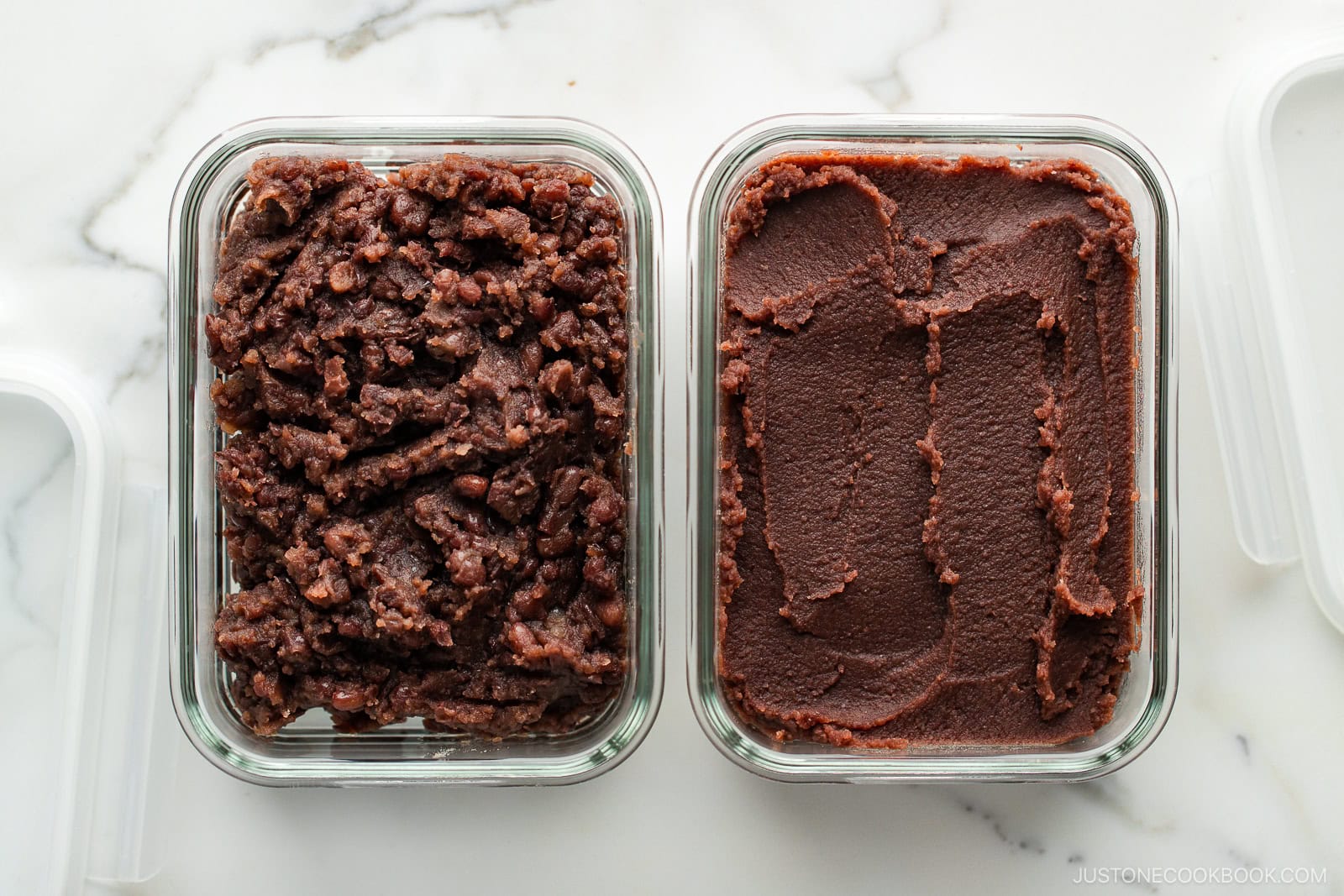
Nami’s Recipe Tips
- Skip overnight soaking – Azuki skins soften during cooking, so you can start right away. No soaking needed with modern beans!
- Throw away the boiling water – This removes the astringency (shibumi, 渋み) of the food. I do it just once, while some people do it twice or three times.
- Bean-to-sugar ratio – A traditional 1:1 ratio preserves the paste longer. I like slightly less sugar at 175–200 g for 200 g beans for balanced flavor.
- A pinch of salt matters – Salt enhances sweetness without extra sugar.
- Stop at the “line test” – Remove from heat as soon as you can part the paste with a spatula; carry-over heat thickens it further.
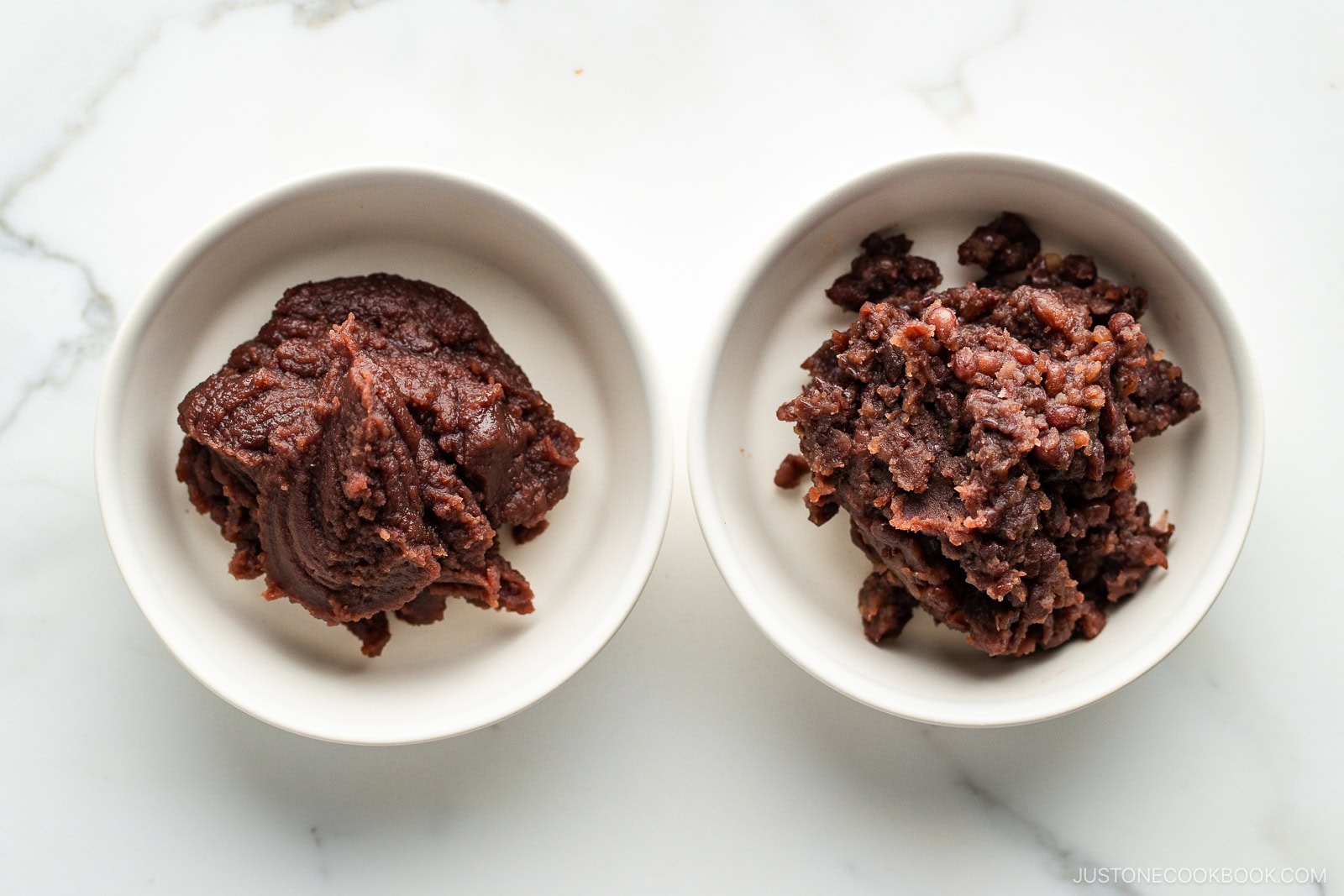
Variations and Customizations
- Instant Pot shortcut – For speed, see my Pressure Cooker Anko method.
- Use white beans – For a milder taste, make my White Bean Paste (Shiroan) recipe.
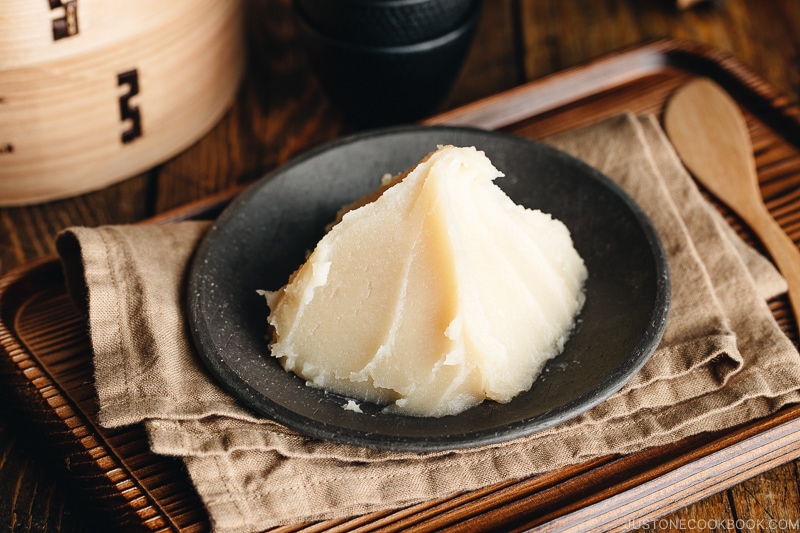
How to Use Anko
- Tsubu-an: Use the chunky type of anko in Zenzai (Red Bean Soup), Anpan, Red Bean Pancakes, or Ujikintoki (Matcha Shaved Ice).
- Koshi-an: This fine paste is perfect for Strawberry Mochi (Ichigo Daifuku), Sakura Mochi, or Manju.
- Get creative: Use as a filling in your favorite pastries or topping for ice cream.

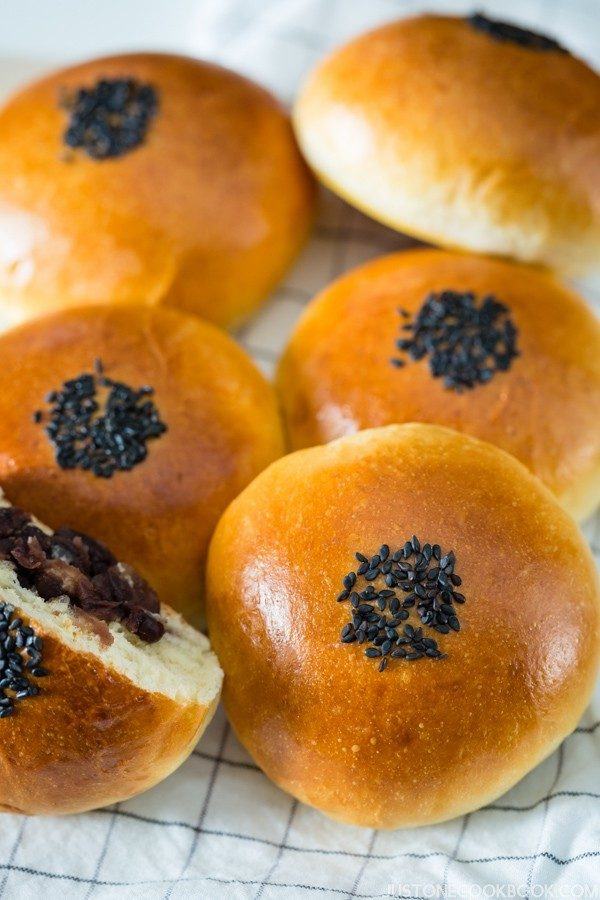
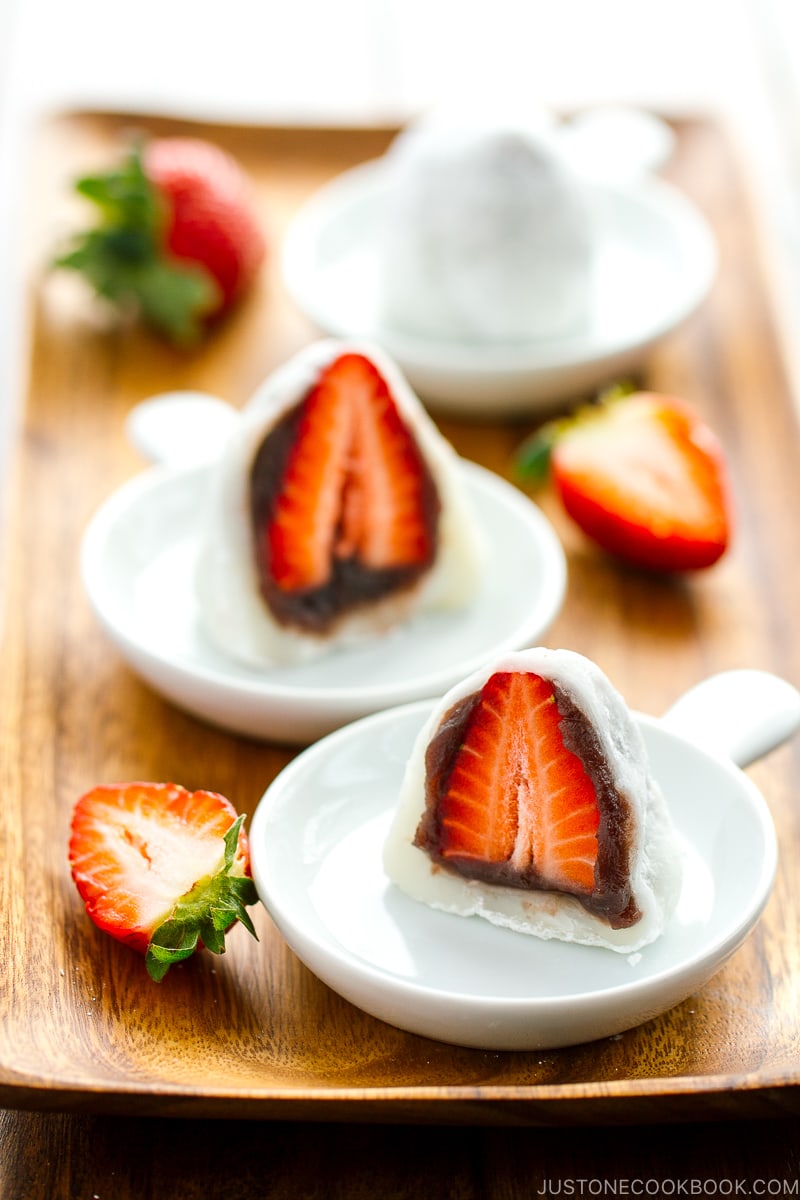
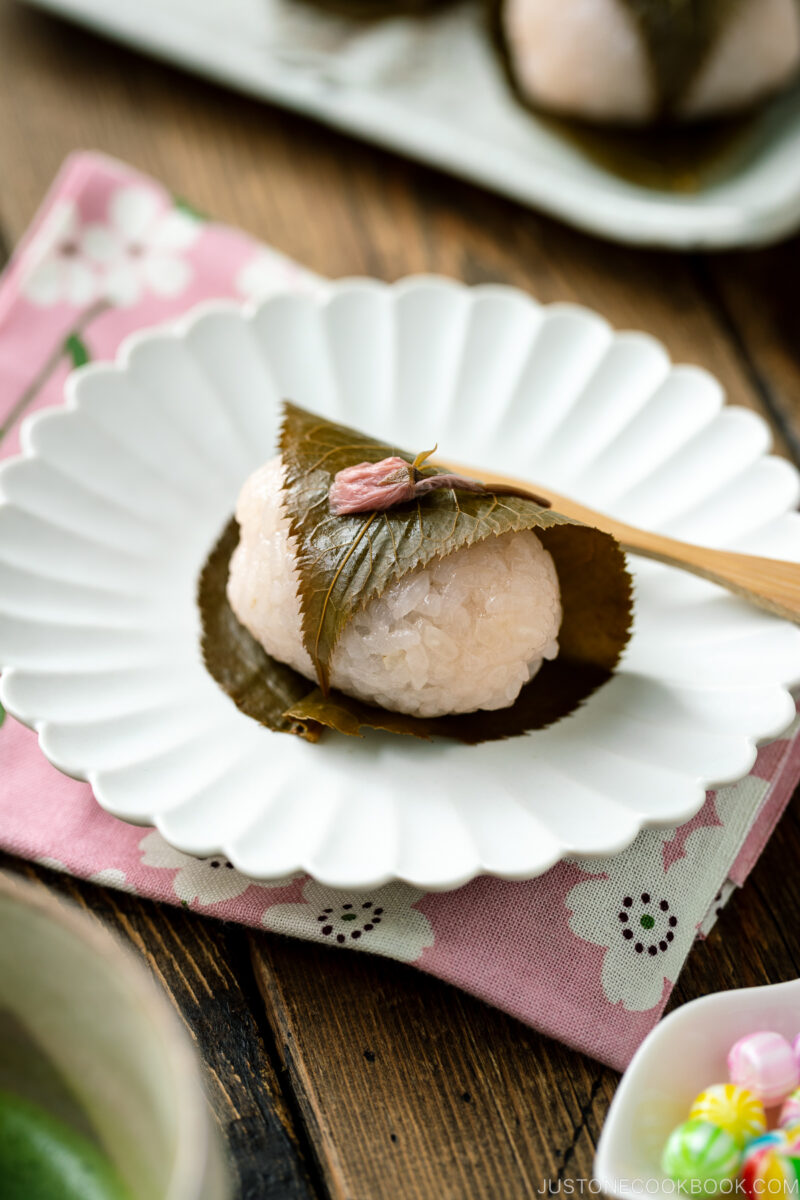
Storage Tips
To store: Cool completely, pack into an airtight container, and refrigerate 3–4 days.
To freeze: Portion 100 g scoops, wrap, and freeze for up to 2 months. When ready to use, thaw overnight in the fridge.
Frequently Asked Questions
Less sugar shortens shelf life. If you reduce it below 75 percent of the bean weight, freeze any paste you will not use within three days.
Salt suppresses bitterness and lifts the natural sweetness of the beans—try it and taste the difference.
Stir in a spoonful of the reserved cooking liquid (or hot water) over low heat until you reach the texture you like.
Follow the koshian steps from the start. Using a food processor means you don’t need to sieve out the skins.
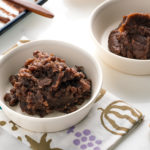
Sweet Red Bean Paste (Tsubuan and Koshian)
Ingredients
- 7 oz azuki beans (dried; a bit less than 1 cup)
- water
- ¾ cup sugar (up to 1 cup or 200 g, to taste)
- ½ tsp Diamond Crystal kosher salt
Instructions
- Gather all the ingredients.
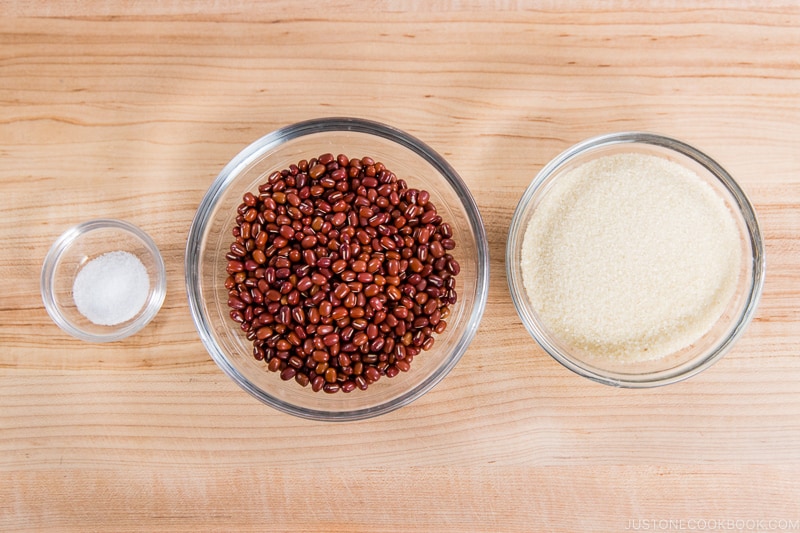
- Rinse 7 oz azuki beans and discard any broken beans. Drain.
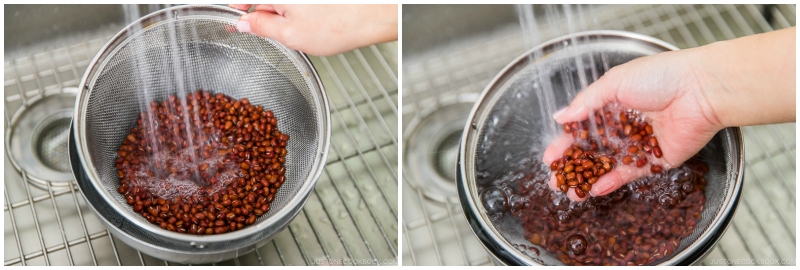
To Parboil
- Transfer the beans to a large pot and enough water to cover them by 1–2 inches.
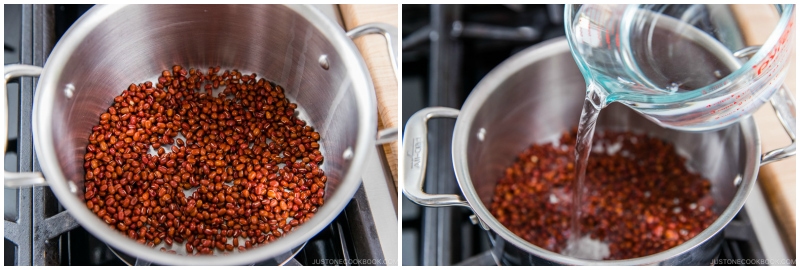
- Place the pot on the stove and bring it to a boil over medium-high heat.
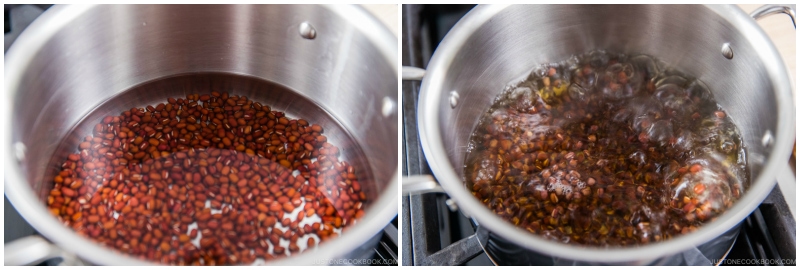
- Once boiling, drain the beans in a fine-mesh sieve. Return the beans to the same pot.
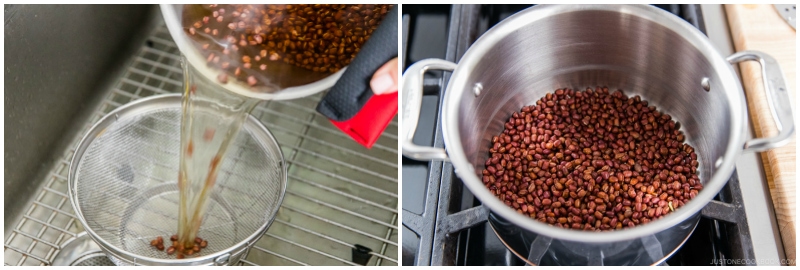
To Cook
- Add more water to the pot to cover the beans by 1–2 inches.
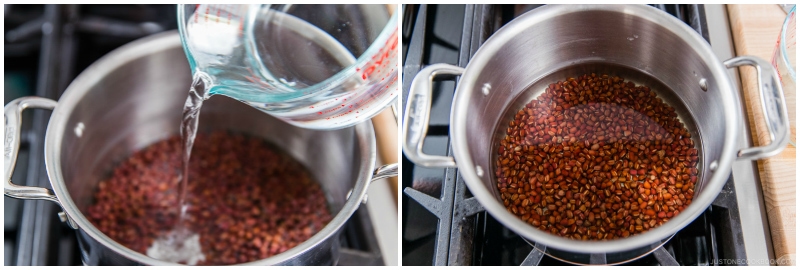
- Bring it to a boil over medium-high heat. Once boiling, put an otoshibuta (drop lid) on top of the beans. Reduce the heat to medium low and keep it simmering for the next 1–1½ hours. Tip: The otoshibuta will prevent the beans from dancing around too much. Learn how to make it yourself or find one on Amazon and JOC Goods.
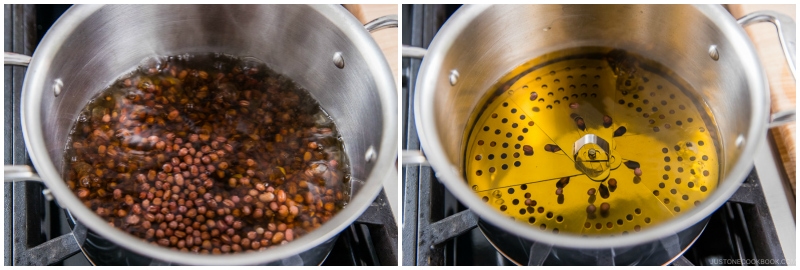
- Some of the liquid will evaporate, so add more water to keep the beans covered, as needed. After 1 hour, check if the beans are cooked. Pick up a bean and mash it with your fingers. When it mashes easily, it‘s done.
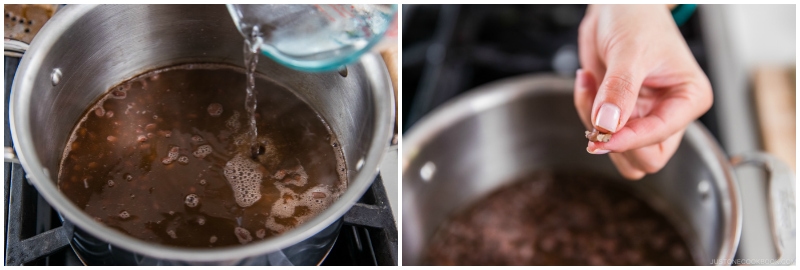
To Make Tsubuan (Chunky Paste)
- Drain the cooked azuki beans in a sieve.
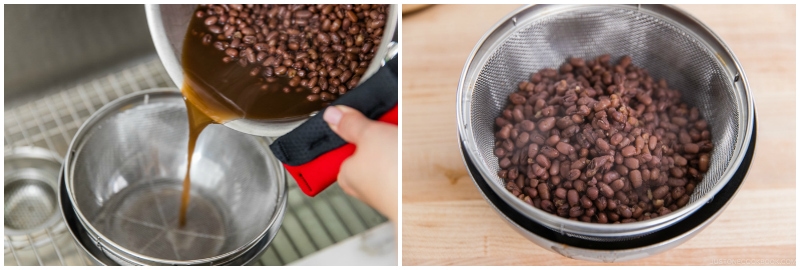
- Return the beans to the same pot. Turn the heat to medium low and add half of the ¾ cup sugar.
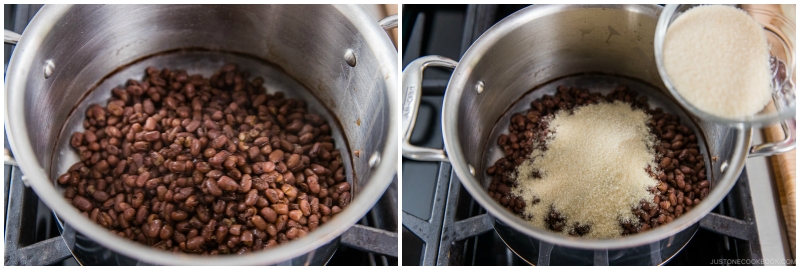
- Mix well. Once the sugar has dissolved, add the rest of the sugar.
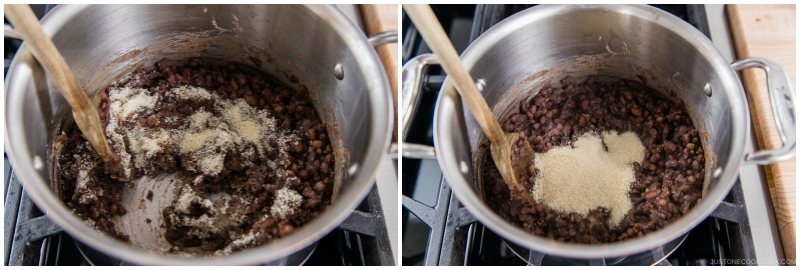
- Mix well, stirring constantly. Then, add ½ tsp Diamond Crystal kosher salt and stir.
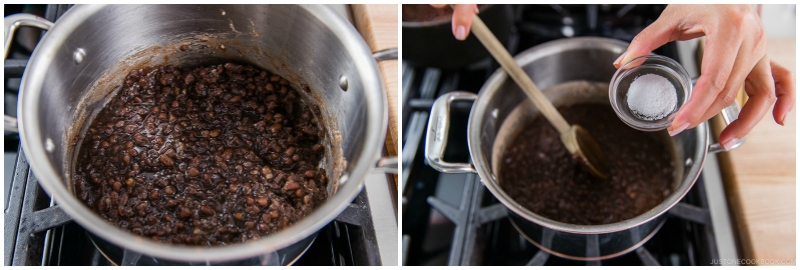
- If you plan to use the red beans for Zenzai (Oshiruko), you can use it right away. If you prefer a thicker version, reduce the soup further.
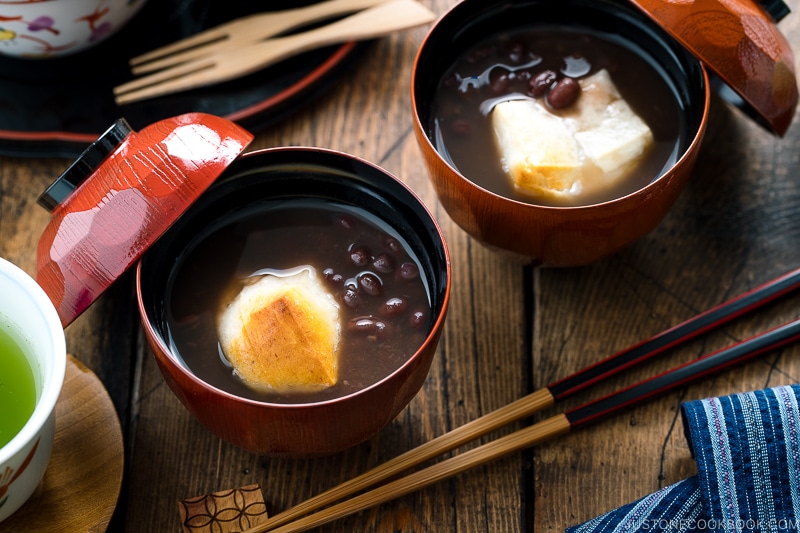
- Let the moisture evaporate. When you can draw a line on the bottom of the pot with your spatula, turn off the heat. Don‘t worry if the anko is still loose; it will continue to thicken as it cools. Transfer it to a flat baking sheet to cool completely. The tsubuan is now ready to use in Japanese sweets like Daifuku Mochi, Anpan, Red Bean Pancakes, and Matcha Zenzai (Red Bean Soup). Scroll down to see how to store it.
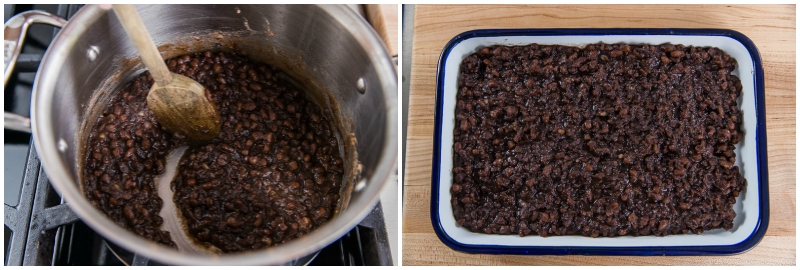
To Make Koshian (Fine Paste)
- Reserve some of the cooking liquid. Then, drain the azuki beans in a sieve.

- Transfer the beans to a food processor. Run the food processor until the beans become a fine paste. If necessary, add 1–2 Tbsp cooking liquid to help it purée smoothly.
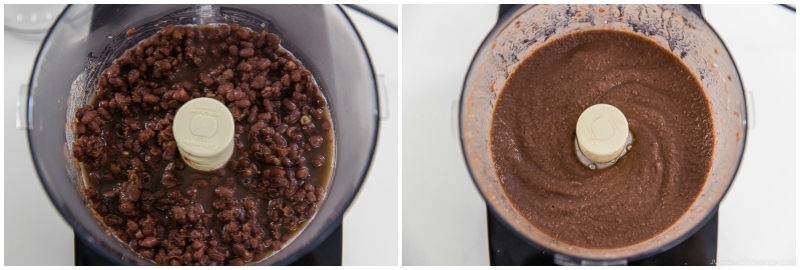
- Transfer the fine paste back into the same cooking pot. Turn the heat to medium low and add half of the ¾ cup sugar.
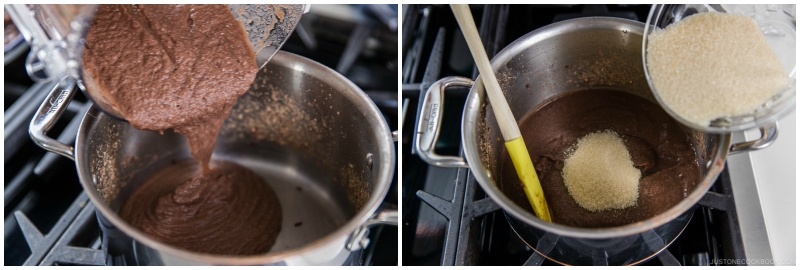
- Mix well. Once the sugar has dissolved, add the rest of the sugar.
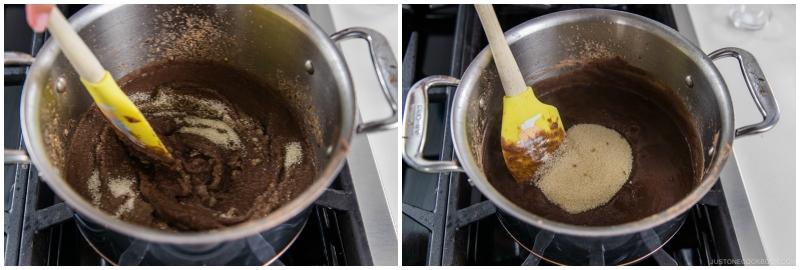
- Let the moisture evaporate, stirring constantly. Add ½ tsp Diamond Crystal kosher salt and continue to stir.
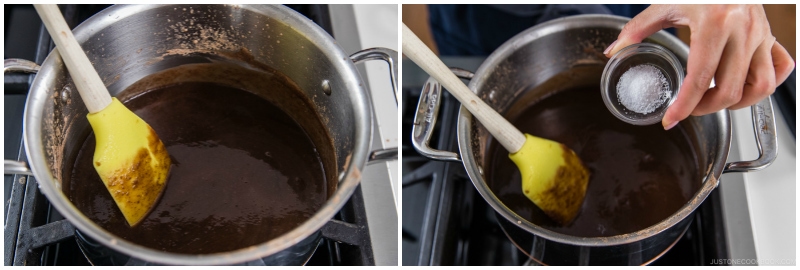
- When you can draw a line on the bottom of the pot with your spatula, turn off the heat. Don‘t worry if the anko is still loose; it will continue to thicken as it cools. Transfer the anko to a flat baking sheet and cool completely. The koshian is now ready to use in Japanese sweets like Strawberry Mochi (Ichigo Daifuku), Sakura Mochi, Manju, and Mizu Yokan.

To Store
- Transfer the anko to an airtight container, cool, and store in the refrigerator for up to 3–4 days or in the freezer for up to 2 months. You can also divide and wrap 100 g portions in plastic film and store in a freezer bag. When you’re ready to use it, defrost it in the refrigerator overnight. Tip: Compared to store-bought red bean paste, homemade anko uses less sugar and therefore doesn‘t keep as long.

Nutrition
Editor’s Note: This post was originally published on March 12, 2012. It was updated with new images and a minor recipe instruction tweak on March 10, 2020. It was republished on June 18, 2025, with refreshed content and improvements.


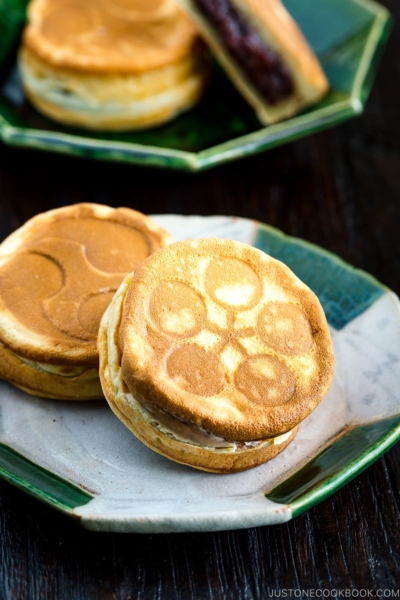
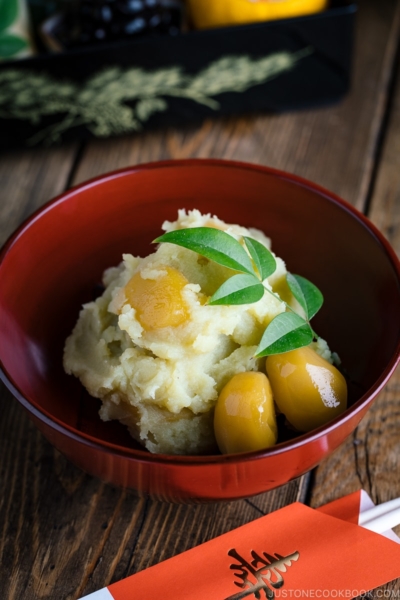




Thank you for posting this! Your directions are very clear.
Anko cannot be bought locally… but I did track down a source for the beans, so I plan to play soon with your recipe. I own a mouli (hand-cranked food mill), so I might even experiment a bit to see if I can make a bit of koshian, too! 🙂
Hi Elizabeth! Thank you so much for your kind words. How cool to own a mouli! We use a very fine sieve and press anko through it, but I wonder how a mouli would work for koshian! Let us know your experience if you try! 😀
Hello Nami,
I made the anko today — it had a pretty good flavour for beans from the local Bulk Barn (my only source for the dried beans — Heaven knows which brand they are). And, the mouli worked! I now have a batch of koshian.
If anyone else reading this is confused about just what a mouli is, I should add that American suppliers tend to call them hand-cranked, or manual, food mills. The name mouli is used more in the UK; I’ve heard both terms used here in Canada. They are the niftiest gadgets for making soups and preserves and now I know that they can also make koshian. 😉 My mouli, bought at our local Home Hardware, came with three grating discs — I used the finest gauge to sieve the anko.
I had been debating whether to mill the anko hot or cold; ended up doing it hot as it was already quite thick. In fact, it was the thickest thing I’ve put through the mouli. Near the end, I kept scraping down the paste so that the turning blade would catch it (the nice thing about a hand-turned food mill is that there’s no danger of catching a finger or utensil while doing this as you have to stop cranking, heh!) There was very little waste when I was finished — maybe a teaspoon left over in the mouli. You could see a difference in the colour of the paste from start to finish as the bean skins were slower to make their way through the mill, so I just stirred everything together. The final product was a very smooth paste — not certain if it would pass muster in a Japanese kitchen, but I’m happy with it. 🙂
And, I have fresh strawberries… Hmm. 😀
Best wishes,
Elizabeth
p.s. Maybe for proper koshian, there should have been less of the skins in the final product, Nami? Or, do you also force the skins through the sieve when you make koshian? What do you think?
Hi Elizabeth! Thank you SO MUCH for the update! I had really fun reading your full report! Wow I wished that I could see the process in person. It must have been a very interesting and fun (and delicious!) project. Usually Koshian doesn’t have skin in it, but depends on the brand or preference, you could add some skin for texture. It’s amazing you only had about a teaspoon worth of waste in the mouli afterwards. I hope you enjoy homemade koshian! I have to try making it one day… yeah one day… 🙂
Hi Namiko-san! Thank you for your easy to follow recipe. I’m cooking the anko right now and the smell of adzuki beans cooking away makes me so happy 🙂
Question, will the recipe still work well if you keep a lid on the pot while it simmers for the 1+ hours? Wouldn’t it save having to add additional water throughout?
Kind regards,
Olivia
Hi Olivia! I hope your anko turned out well! You have a very good question. I cook with no lid without thinking (from my memory of my mom and grandma cooking) but your question made me curious, so I checked other recipes online (mostly videos). Most people cook without lid, and some mention that you need to make sure the water amount. In order to keep the beans in good shape (and texture), we cook the beans under the water just above the beans. If you put too much water, beans will dance around in the water and it will easily break (according to the theory). When you close with the lid, you can’t see how the beans are doing (moving too much or covered by enough water), so most people leave the lid open to keep checking. Some people use Otoshibuta (drop lid) instead of regular lid so that beans won’t be moving too much. Hope this helps!
Hello,
I love your recipes, I was wondering if you had the calorie per serving breakdown for the green tea ice cream and the red bean ice cream. Also, perhaps I missed it on the website, if so please direct me to the calorie break down for recipes.
Hi Danielle! Thank you for reading my blog! Unfortunately, as I am not a registered dietician, I am not comfortable sharing nutritional information for any of my recipes. I recommend utilizing online calorie counters at your discretion to obtain such information. I know it would be very convenient though. 🙂
Dear Nami,
I see. Anyway I made dorayaki with the tsubuan. Hehe. Really enjoy trying out the recipes. I hope one day you will publish a hard copy cookbook!
🙂 Christine
Hi Christine! So sorry for my late response. I’m so happy to hear you enjoy my blog! Thank you for following! 🙂 Awww thank you so much for your interest in a hard copy cookbook. Well, I barely have time to keep up with my blog right now with 2 posts per week, and I’m responding to readers so slow… =P Maybe one day, when kids are much older. Thank you Christine!
Dear Nami,
I managed to get another packet of adzuki beans from my local Isetan. It says King Dainagon Azuki so hopefully it will work this time!
I am going to experiment with only 100g
of beans.
Btw I just grabbed another 2 packets of Sanuki Udon again today. I have tried your
yaki udon, miso soup, nikujaga and okonomiyaki recipes so far. They all work great! Except for my okonomiyaki which I added too much cabbage. The whole mixture didn’t really hold well together.
🙂 Christine
Hi Crhsitine! Those azuki beans are from Hokkaido and they are a bit bigger and more expensive (I used dainagon too). Hope anko will come out well.
You will need a good balance of batter vs. cabbage. If too much batter, then Okonomiyaki is like a real pancake. Too much cabbage, then like you said, it breaks easily (not enough connector). To find the good balance, slowly add cabbage to the batter and mix it all up until you add next handful of cabbage. Depending on the amount you are making, you can also transfer some batter and cabbage into a smaller bowl to control the portion/ratio. Hope this helps. 🙂
Dear Nami,
The tsubuan turned out well this time. I am thinking I must have used the wrong beans previously. I saw them labelled as kintoki beans in Isetan. 🙁 Which is really strange as my tour guide told me they were azuki beans when I bought them in Japan.
Thanks for all your help.
Hi Christine! Glad it worked out this time! Oh I see. Kintoki Mame is different from Azuki beans. They are used to make a simmered side dish like this (https://www.google.com/search?q=%E9%87%91%E6%99%82%E8%B1%86&client=firefox-a&hs=ovy&rls=org.mozilla:en-US:official&channel=fflb&tbm=isch&tbo=u&source=univ&sa=X&ei=z2vqU4TXJIXUiwK91IGYAg&ved=0CCwQsAQ&biw=1600&bih=729). Sorry the tour guide was not aware of it… :/
Can i use regular red beans?
Hi Mika! If you are going to make anko, please use azuki (or adzuki) beans. Thank you. 🙂
Dear Nami,
Thank you so much for your reply.
Yes the beans became smooth again after
soaking overnight.
However the insides of the beans were cream so I ended up with a paste that was more pinkish than red. And I must have misread your recipe as I threw out the water I cooked the beans in before adding the sugar. 🙁
I will try again with another pack of beans.
Regds,
Christine
Hi Christine! I’m glad to hear the bean’s wrinkle problem was solved. 😀 I think the color of beans are based on the kind of beans, so you may not be able to change it. Hope next pack of azuki works better. 🙂
Hi Nami,
It is my first time attempting anko.
Are the adzuki beans supposed to look
shrivelled after soaking? My beans had
smooth surfaces initially but looked a little
strange after soaking for only 1 hr.
Also, do we top up with tap water or hot water when the water evaporates? Thanks!
🙂 Christine
Hi Christine! I did some research on the wrinkles after soaking, but couldn’t find the same case. However I read the same thing happened to soybean (daizu) and the reason was that the skin is soft and got expanded first by hydrating. But the wrinkles disappear when the soybean (inside) start to expand after hydrating. That kind of makes sense and I wonder if your wrinkles also disappeared after soaking for more hours.
The wrinkles for azuki usually happen after cooking and cooling, but it was my first time hearing about wrinkles before cooking. Hope the result was okay.
We use water (I use filtered water) instead of hot water. Hope this helps!
How long can you keep Anko?
I’m not quite sure if I’m going to use it up in one time.
Thank you :))
Hi Patt! Wrap in plastic bag and store in Ziploc Freezer bags, and then store in fridge for a week and freezer for up to a month. 🙂
The pictures were really helpful. I ended up adding the sugar a bit too early i think and had to evaporate more water to get the proper texture but it still came out great. Now to use up the paste in your other recipes :p
Hi Matiwariat! So glad to hear my step by step pictures were helpful. Thank you so much for your kind feedback. 🙂
Have you ever done this in bulk, say 20 bags of beans at once?
To elaborate, I have tried your recipe and it came out really well; I used it for taiyaki. Yay. Now I have an ambition to serve the azuki with shave ice here in Hawaii for a fundraiser and will need a lot of azuki. I am planning on making 20 bags worth in one big pot and was wondering if you ever made this recipe in bulk, and if you had or know of any issues with cooking this much at once.
Mahalo for your time!
Hi Fukukawa-san! I’m glad your anko came out well! 🙂 Theoretically, it should work. I’ve seen my mom and my grandma cook for a bigger batch. As long as the beans are “equally” cooked, it should be okay. While cooling the beans, the moisture evaporate and it’ll become harder. If you need anko to have some moisture/softer, please be careful not to lose too much liquid. 🙂
Good luck!
Will update if I run into any issues. Arigato gozaimasu for the quick reply! Aloha
Thank you so much! Hope your fundraiser will be successful. If I was in Hawaii, I’d be your frequent customer because I love shaved ice with matcha and azuki! 🙂
Hi again,
Update: the azuki with shave ice was a hit. Topped everything off with sweetened condensed milk. Winner! The only problem I had was cooking the beans. I had to break up the batch into smaller batches because cooking 20 bags all at once was taking too long. Also, 20 bags was A LOT, too much for the biggest pot haha. All in all it was a success. Thank you so much for this recipe! Aloha, Deron Furukawa
Hi Deron! Thank you for the update! Awesome news! So glad to hear the azuki with shaved ice was a hit! I need to buy a shaved ice machine this year… 🙂 I wish I live nearby so I could have leftover anko! Thanks again!
Hi Nami: Success! We now have red bean paste cooling in the fridge. I loved that you explained “how” and more appreciated the “why” so I had no surprises and was assured success. I was introduced to red bean paste in Korea and enjoy it very much as a substitute for chocolate…..but really there is no substitute for chocolate. I have read the comments to this recipe and I don’t think you would ever be able to substitute the sugar for a low/no calorie option as a sugar is needed to caramelize the beans. Thank you…this is a “keeper” recipe for me and I will be creating a cheesecake w the paste I made today.
Hi Karen! So glad to hear your anko turn out well so far! I am also happy that you thought my instructions were helpful. Thank you so much for your feedback, as well as feedback on sugar. 🙂
You’ll make cheesecake with red bean paste! Wow I’ve never tried that before and I’m jealous you get to eat it. 🙂 Hope you enjoy anko!
Thank you for posting this! I’m interested in making mochi and this recipe will help me know how to cook the beans just right! Can you direct me to a good mochi recipe?
I also have discovered a red bean boba shake and I would like to try making it myself as I think it would be tasty even without boba added.
Hi Elizabeth! I’m going to do the mochi tutorial one day with video, but meanwhile, you can check out this Strawberry Daifuku as a basic recipe.
https://www.justonecookbook.com/recipes/strawberry-daifuku/
Red bean boba is my favorite drink! I always ask for red bean on the side, even though there is no red bean boba as a menu. 😀
When I tried to make koshian before, I stored it in a glass jar (unsealed) in the refrigerator. Sugar crystals formed in the koshian afterwards. How do I prevent that? Did I do something wrong in the recipe? I may have used more sugar than suggested.
Hi Kira! To tell you the truth, I am not sure. I have never made koshian before, and with regular anko I haven’t had this issue before. Is it really bad that you have to cook it before using it? Wish I can help, sorry. 🙁
in step 1, when you say to soak the beans overnight, how many hours would you say is “overnight?”
Overnight usually means 8-12 hours. I updated my recipe with the info. Thank you!